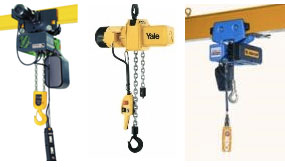
Electric Hoists are a type of lifting equipment that is used for lifting, lowering, and moving heavy and large objects. The main types of electric hoists are Electric Chain Hoists and the Electric wire Rope Hoist. There are always newer designs and technological advances in progress and are ones to look out for. One of the latest is the 2nd generation DEH Delta electric hoist available in the UK at great prices only from Lifting Gear Direct.
Thanks to their flexibility and versatility they are able to adapt
to many lifting operations. While onsite the Electrical
Hoists may be used as standalone equipment such as when it is anchored to an existing structure or as part of a lifting system such as with a trolley on a lifting gantry or Jib crane perhaps. The type of hoist will
affect the travel speed and lifting speed of the electronic hoist and
therefore, will influence the production rate and turnaround time of the
operation.
Electric chain Hoists must be compatible with the beams of the lifting
system’s structural frame as well as the electrical hoist. The Trolley is a
vital part of the production process because they are responsible for
transporting the Electric Hoist across the length of the beam. There are various types of Electric Hoist
Trolleys, such as:
·
The Push
Trolley
·
Geared
Trolley
· Electric Travel Trolley

The Electric Hoist comes with lifting regulations that must be observed to uphold safety. These regulations are based around their rated capacity, working load, and duty cycle which are the critical specifications of Electrical Hoists.
Many Electric Hoists have built-in safety features, and the hooks
will have catches for safety so the lead will not become disengaged. There are
clutch systems on most electrical hoists which slip at a pre-set torque, this
prevents the device from overloading which can become very dangerous.
Electrical Hoists are made with a switch mechanism, this is where
the chain will mechanically engage when an overload occurs. New Electric Hoists like the Delta DEH will come with a safety cut-out switch for emergencies, these are extremely
important for safety reasons.